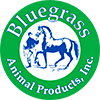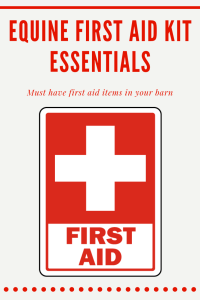Equine, Uncategorized
Equine First Aid Kit Essentials
While we do everything we can to protect our horses, sometimes accidents happen. Sometimes it seems our horses will search out any way possible to injure themselves despite our best efforts, which is why its good to always have a fully stocked vet kit in the barn. In addition to the equine first aid kit outlined below, you should always have a human first aid kit in the barn.
It’s important to remember to replace things as you use them and as they near expiration date for items that haven’t been used.
With many things on this list it is important to know how to properly apply/use the item. We recommend working with your veterinarian to discuss what items would be best for your first aid kit and how to use those items, this kit lists items we feel would be helpful but your vet may have other recommendations. Items with an * are ones we think its especially important that you talk with your vet about. It is very important to know how to properly wrap your horses leg/hoof and give medications!
Equine First Aid Kit
Betadine or Chlorhexadine solution – wash cuts/scrapes. mix with epsom salts for a foot soak
rubbing alcohol
SWAT ointment – can put over small wounds to help prevent flys from bothering the area
Bottle contact solution
Alushield spray – aerosol bandage apply after thoroughly cleaning the wound. helps to keep flys away and bacteria out
Vaseline – coat thermometer before use, can use for mild bit rubs (if your horses bit is rubbing you want to check your tack to make sure it is the correct size and adjusted correctly)
Diaper rash cream
Furazone /Furafree – can be used as a wound ointment, can be used in a sweat. If using furazone its important to wear gloves.
Triple Antibiotic cream
DMSO – often added to a sweat (be cautions using this product and what products you mix it with). Always wear gloves when applying.
Derma gel – used for wounds and provides a barrier to keep bacteria out of the wound while it heals
epsom salts – mix with warm water and betadine for a foot soak.
Electric kettle – used to heat water very quickly. You want to be careful not to use boiling water on your horse but you can mix with cold water until desired temperature.
epsom salt poultice
Deluxe Equine Slipper used for hoof injuries. Keeps the hoof clean and avoids the typical cotton, vetwrap, elasticon and duct tape bandage.
animalintex poultice pads – soak and use to treat hoof abscesses or to poultice a leg
poultice – use on legs after a hard workout or to help tighten up an injury, make sure not to use typical poultice over any open skin. poultice is often applied and then covered with wet paper and then a standing bandage *
clear cling wrap – used for a sweat bandage *
sterile non stick guaze
diapers
mazi pads –can use to help cover and stop the bleeding on an injury
roll cotton – can use for wrapping a leg/covering an injury *
clean stable wraps – want to have a set for the fronts and a set for the hinds *
flashlight with batteries
disposable latex gloves – these are used often around the barn! use when applying poultice to make clean up easier, when treating a wound, whenever using Furazone, DMSO and many other products
thick work gloves
wire cutters
clean bucket – label first aid use only
clean tub for foot soaking
tall tub for icing (clean muck tub)
clean sponge
clean washcloths – we like to keep clean washcloths in a sealed plastic baggie.
clean towels (hand and body size)
new, clean flymask
bandage scissors – these are safety scissors for when removing a wrap from the horse.
tweezers
vetwrap
duct tape
elasticon
scissors
thermometer
hoof pick
electrolyte paste
electrolyte powder
equiotic paste – probiotic paste for horses.
60 CC syringes
30 CC syringes to
10 CC syringes
instant heat and ice packs
Banamine (we recommend the tube for ease of use. If you choose to use the injectable form remember that it is never to be given IM. Injectable banamine is for IV use) *
Bute *
sedative – talk to your vet about this. It’s often a good idea to have a sedative or a calming agent on hand for an anxious horse. *
The University of Minnesota talks about Basic First Aid for your Horse and Preparing for Emergencies – this can be a helpful resource to have and a good starting point when talking with your veterinarian about what you can do to be prepared.


Wow! You share is very useful and nice information that every horse owner should. We all know because of enough safety, accidents may happen sometimes. As a horse owner, we do so many things for our horse safety. First Aid Kit for a horse is very important in case of an accident. I added some of the important things in my First Aid kit. But by reading this blog, I added Triple Antibiotic Cream, diapers, wire cutters, electrolyte paste, 60 cc syringes, and duct tape. I keep handy this first aid kit in my carry bag. Thanks for sharing such useful information.